| home > report on operations > financial position > Review of Balance Sheet |
home > report on operations > financial position > Review of Balance Sheet
Income Statement
The Parent Company income statement
for 2009 recorded a net loss of 79.9
million euros, against a loss of 37.0
million euros in 2008.
The following section provides an overview
of the main items of the Income Statement
and the reasons behind the more
significant changes from the previous year,
taking into account the merger by
incorporation of the company Rai Click,
which did not have significant effects.
Revenues from sales
and services
Revenues from sales and services consist
of licence fees, advertising revenues and
other commercial revenues.
They totalled 2,969.9 million euros, up
16.4 million euros (+0.6%) on 2008.
Licence fees (1,645.4 million euros).
These include licence fees for the
current year as well as those for
previous years, collected through
coercive payment following legal
registration, as highlighted in the
following table.
The total increase (+1.6%) is mainly
attributable to an increase in the perunit
licence fee from 106.00 euros to
107.50 euros (+1.4%), with the
remainder accounted for by an increase
in the number of paying subscribers.
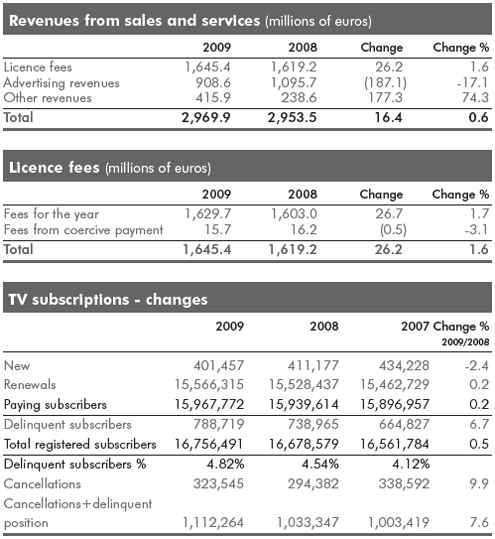
Once again, in 2009 the licence fee
paid in Italy continues to be the lowest
in Western Europe. By way of example,
the table shows the annual licence fee,
in Euros, in force in selected European
countries.
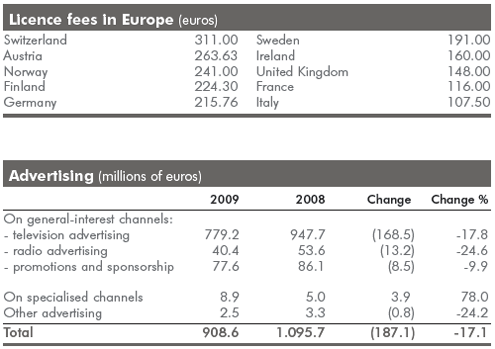
Advertising revenues 908.6 million
euros) show a drop of 187.1 million
euros (-17.1%) on 2008. This decline in
advertising revenues is largely
determined by the severe international
financial recession which characterised
the end of 2008 and the whole of
2009, causing significant contractions in
the Italian and international economy.
This led to a considerable reduction in
advertising investments, strong
accentuated in 2009 by big sporting
events, which had characterised the
previous year.
The reference market (TV and Radio)
showed an overall decline of about
9.9% (source Nielsen) in 2009.
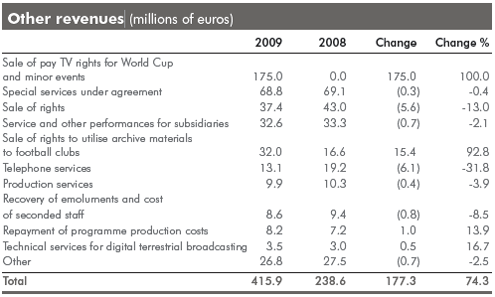
Other revenues show an increase of
177.3 million euros (+74.3%), owing
mainly to the sale to third parties,
during the year, of the pay TV rights to
broadcast the 2010 and 2014 World
Cup matches and other minor FIFA
events, for the sum of 175 million
euros.
Other factors, of little significance when
considered individually, are highlighted
in the table on the right. Positive items
included the effects of the agreement
entered into with a leading sports
company, booked to Sale of rights to
utilise archive materials to football
clubs, while negative items included
lower revenues from Telephone services
and Sale of rights.
As shown in the table on the right, the
relative weights of the three components
on total revenues from sales and
services show an increase in the Licence
Fees and Other revenues items
compared with the totals for the
previous year, to the detriment of the
Advertising component.

Operating costs
These total 2,754.7 million euros, rising
49.6 million euros, 1.8%, compared
with 2008, as detailed below.
The item includes internal costs (labour
cost) and external costs, regarding
ordinary business activities, according to
the following classification.
External goods and services - This
caption includes purchases of goods
and services required to make
programmes of immediate use
(purchases of consumables, external
services, artistic collaborations, etc),
filming rights for sports events,
copyright, services from subsidiaries,
running costs (rental and hire fees,
telephone and postage costs, cleaning,
maintenance, etc.) and other operating
costs (direct and indirect taxes,
contribution to the Authority, the public
broadcasting concession fee, etc.).
As shown in the table, the caption
shows an increase of 48.7 million euros
(+2.7%), determined by the cost of the
pay TV rights to broadcast the 2010
and 2014 World Cup matches and
lesser FIFA events equating to 169.3
million euros subject to the
aforementioned sale to third parties.
Net of this component, the caption
amounts to 1,681.8 million euros,
with a reduction of 120.6 million
euros, mainly from the reduction in
costs for the purchase of filming rights,
mostly relating to sports broadcasting
rights (-143.2 million euros). In relation
to this, the absence in 2009, as in all
other odd years, of important four-yearly
sports events (European Cup Football
Championships and the Olympic
Games), which had influenced the
Income Statement by 164.6 million
euros, should be signalled.
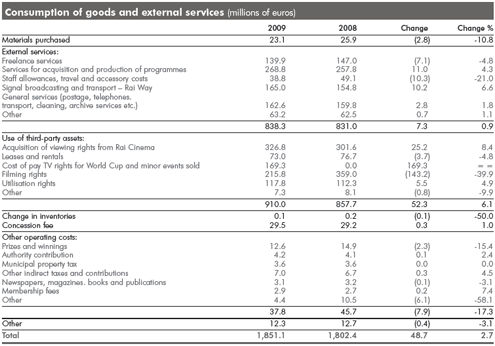
Personnel costs � These amount to
903.6 million euros, up by a total of
0.9 million euros on the total at 31
December 2008 (0.1%), as detailed in
the right-hand table.

As for the previous year, the personnel
cost containment trend was confirmed,
recording figures well below the level of
inflation.
This result is due to various managerial
interventions. First of all, the positive
effects of incentives in 2008 and the
new incentives in 2009 made it possible
to offset the economic impact deriving
from the stabilisation of those on
temporary work contracts and to
significantly limit the physiological
growth of labour costs deriving from
contractual renewals, meritocratic
policies and rises related to length of
service.
Alongside incentive policies,
interventions on all the variable captions
(overtime, rises ad remuneration
policies) weighed positively on the
containment of labour costs, as did the
reduction of the severance pay fund
revaluation index.
Personnel on payroll at 31 December
2009 amounted to 9,953, up 79 on the
same date of the previous year.
The average number of employees,
including those on fixed-term contracts,
came to 11,829, with an increase of
131 compared to the previous year, due
to an increase of 77 members of staff
on permanent contracts and an increase
of 54 in the number of staff on fixedterm
contracts.
Gross Operating Margin
The Gross Operating Margin, as a
consequence of the above, is positive
for 230.6 million euros, down 32.5
million euros, or 12.4%, on the previous
year.
Amortisation of programmes
This caption is related to investments
in programmes, which during 2009
amounted to 287.6 million euros, down
29.1 million euros (-9.2%), mainly due
to TV fiction series which ends the
growth trend that has characterised
previous years.

Amortisation charged for the year in
relation to the above captions,
amounted to 261.2 million euros, rising
6.2 million euros (+2.4%) compared
with the previous year. This albeit
modest growth was due to the positive
influence during the year in progress of
the major investments made in previous
years.

Depreciation
and other amortisation
This is linked to investments in tangible
non-current assets and other
investments, the movements of which
during 2009, highlighted in the
following table, presented an overall
increase (+5.3 million euros).

Depreciation and other amortisation charged for the year in relation to the
above captions amount to 78.2 million
euros, with a drop of 12.2 million euros
compared with 2008, referring almost
entirely to tangible non-current assets, in
relation to the progressive completion of
the amortisation of assets acquired in
the past, in the presence of a contained
level of investment.

Other net income (charges)
This caption comprises costs/revenues
not directly related to the Company's
core business and, in 2009, highlights
net charges of 35.4 million euros (net
prior-year income of 28.0 million
euros). In greater detail, it comprises
provisions for risks and charges (29.0
million euros), expenses for repeatusage
programmes which it is not
expected will be used or repeated (25.4
million euros), provisions for the
company supplementary pension fund
for former employees (9.7 million
euros), partially offset by net prior-year
income (30.6 million euros). The drop
in the caption compared to 2008 (-63.4
million euros) is largely referable to the
absence of net prior-year income
originated in the previous year by the
results of a transaction regarding
copyright.
Operating Result
The results described above for
operating revenues and costs led to a
deterioration in the operating result,
from �54.2 million euros in the previous
year to -144.2 million euros this year,
with a drop of 90.0 million euros.
Net financial income
Net financial income shows a gain of
1.3 million euros (3.1 million euros in
2008). The caption shows the economic
effects of financial operations and
comprises bank interest expense and
income as well as that relating to Group
companies and net income/expense in
relation to exchange rates.
The details show a drop in net interest
payable to banks of 1.2 million euros
against higher financial exposure to
third parties, partly offset by a reduction
in the rates applied. Low market interest
rates also determined a relevant change
(-4.6 million euros) in interest income
originating from the loan to the
associated companies, despite the high
loan granted to them.
Exchange rate differences, mainly
generated by the acquisition of rights to
sports events in US dollars, were positive
despite being for a limited amount,
thanks to hedging activities carried out
in previous years, which limited the
significant oscillations recorded by the
exchange rate during the year.
The average cost of loans with banks
and other financial institutions, made up
of credit line on current accounts, "hot
cash" and stand-by loans, dropped
considerably in relation to the significant
reduction in the money market reference
rates, setting at 2.3%.

Income from equity
investments
As indicated in the table below, the
caption amount to a total of 47.8
million euros and includes the dividends
collected during the period considered
valid for the results of the previous year
(49.8 million euros) ad the reductions of
the value of equity investments for losses
totalled during the year (2.2 million
euros).
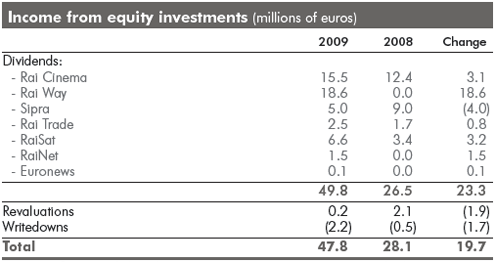
Net exceptional financial
income (expense)
This caption, which highlights net
exceptional income of 1.7 million euros
(net income of 1.0 million Euros in
2008), was originated by expenses (6.7
million euros) for incentivised resignation
linked to the implementation of the 2008
� 2010 three-year plan exceeding the
fund provided in 2007, partially offset by
proceeds linked to the disclosure of credit
for the reimbursement of IRES following
the introduction of the law that made the
IRAP paid during the tax years between
2004 � 2007 (4.2 million euros) partly
deductible and to the recognition of tax
credit for research and development costs
sustained in 2008 (0.6 million euros).
Income taxes
The caption has a positive value of 16.9
million euros determined by the balance
between current and deferred taxes, as
detailed in the table.
As regards the IRES tax, no amount was
booked as the year's result for tax
purposes was negative.
IRAP, amounting to 26.7 million euros,
shows a decrease of 2.8 million euros
compared with the previous year,
determined by a lower taxable amount.
Deferred tax liabilities determine a
positive effect of 13.8 million euros
(11.5 million euros in 2008), as a
consequence of the reversal of the
temporary differences of income
deriving from the higher amortisation
applied in 2007 for tax purposes only.
Deferred tax assets (29.8 million euros)
originated from the booking of IRES
credits for 26.9 million euros deriving
from the year's negative taxable
income, which is offset by the positive
taxable income of subsidiaries, including
within the scope of tax consolidation
mechanism for tax year 2009.

Balance Sheet
Non-current assets

Tangible non-current assets amount
to 333.9 million euros and are
represented by land and industrial
buildings for 38.5%.
The decrease of 11.1 million euros with
respect to 2008 represents the balance
between investment (59.6 million euros),
eliminations (0.3 million euros) and
depreciation (70.4 million euros).
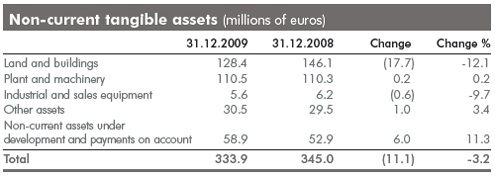
The investments in programmes is
mainly represented by films (360.4
million euros), which accounted for the
greater part of investments during the
year (257.9 million euros).
The change from the previous year
(+0.9 million euros) is the net result of
the following factors:
- investments for 299.4 million euros;
- amortisation for 273.1 million euros;
- writedown of programmes for 25.4
million euros.
Equity investments fell slightly (-1.6
million euros) largely due to the
writedown of the investments in Rai
Corporation and NewCo Rai
International following the losses
recorded by the company.

Other non-current assets are shown
in the following table.
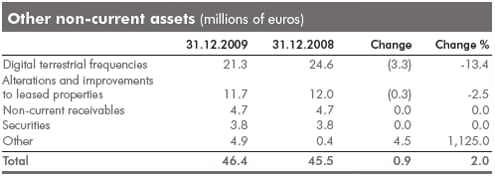
Working capital
The change from 2008 (+63.4 million
euros) is due mainly to normal
developments in the business.
Major changes relate to:
- Trade receivables: show an increase
of 191.3 million euros, owing mainly
to the booking of the amount
receivable for the aforementioned
sale of pay TV broadcasting rights
(115.5 million euros) and higher
amounts receivable for services
rendered to the Government under
contract (72.8 million euros);
- Trade payables: up 124.0 million
euros largely due to the booking of
the cost of pay TV broadcasting rights
sold but not yet liquidated (87.0
million euros) and higher amounts
payable to subsidiaries (40.1 million
euros);
- Provisions for risks and charges show a reduction of 25.4 million
euros, mainly owing to uses/releases
of funds provided during previous
years net of provisions to the funds
during the year.
It should be noted that Trade
receivables comprise, net of the
relative writedowns, accounts receivable
from subsidiaries, mainly Sipra, and
from public entities and institutions.
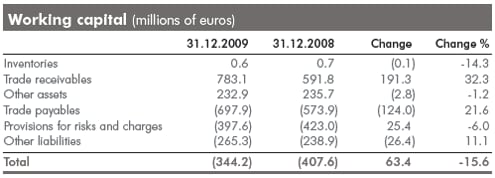
Net financial position
The year-end net financial position is
positive, despite the decline compared
to the previous year (52.5 million euros
compared with 196.8 million euros in
2008), and is comprised as follows.
The reduction of net available funds is
due to the decrease in revenues from
advertising and the liquidation of
receivables in relation to services
rendered to Government by contract.
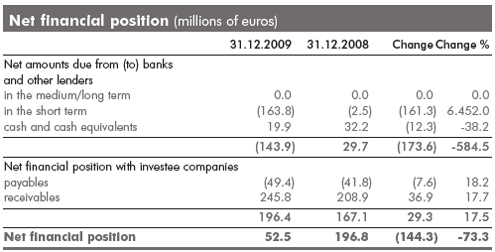
These effects were partly offset by
income from the aforementioned sale of
pay TV broadcasting rights, outlays for
important sporting events and operating
expenses.
The average financial position is positive
by about 66 million euros, down from
the previous year (139 million euros), as
a consequence of the financial profile
described above.
The analysis carried out on the basis of
the balance sheet and income statement ratios highlighted that:
- the net invested capital coverage
ratio, calculated as the ratio between
net invested capital and net equity is
0.89 (0.66 in 2008);
- the current ratio, identified as the
ratio between current assets
(inventories, current assets, cash and
cash equivalents and financial
receivables) and current liabilities
(current liabilities and financial debts),
is 1.09 (1.25 in 2008);
- the self-coverage ratio of fixed
assets, calculated as the ratio of
shareholders' equity to cu rrent assets,
is 0.45 (0.51 in 2008).
The financial risks to which the
Company is exposed are monitored
using appropriate computerised and
statistical instruments. A policy regulates
financial management in accordance
with best international practice, the aim
being to preserve the corporate value by
taking an adverse attitude towards risk,
pursued via active monitoring of the
exposure and the implementation of
suitable hedging strategies, also acting
on behalf of the Group companies.
In particular:
- The exchange risk is significant in
relation to the exposure in US dollars
generated by the acquisition of sports
events rights and the funding of the
associated company Rai Corporation.
These commitments generated
payments for about 70 million dollars
during 2009. Operation takes place
from the date of subscription to the
commercial commitment, often lasting
several years, and aims to defend the
counter value in euros of
commitments estimated at the time of
order or in the budget. Hedging
strategies are implemented using
financial derivative instruments � such
as forward purchases, swaps, and
options structures � without ever
taking on an attitude of financial
speculation. The group policy
envisages numerous operating limits
to be observed by the hedging
activity.
- The interest rate risk is also
regulated by the company policy,
particularly for medium/long-term
exposure with specific operating limits.
At the moment, the financial position
does not contain significant long-term
exposures, but sees short periods of
operational liquidity alternating with
overdraft positions, hedged with
reversible credit lines or stand-by
loans, for which it was deemed
unnecessary to activate hedging
operations.
- The credit risk on cash deployment is
limited in that the company policy
envisages only the use, for limited
periods of cash timing differences, of
low-risk financial instruments with
parties with high ratings. Only tied
deposits or sight deposits with
remunerations close to the Euribor
rate were used during 2009.
- As regards the liquidity risk, it should
be noted that the company has shortterm
credit lines with the banking
system, amounting to about 500
million euros. A stand-by loan for
200 million euros with a duration of
three years was taken out in February
2009 with a group of seven Italian
and international banks. The overall
loans are sufficient to cover overdrafts
although the procedure for liquidating
the four deferred repayments by the
Ministry of the Economy and Finance
can generate tensions in the event of
significant delays with respect to the
quarter-end dates established by
contract. To cope with the significant
investments required by the DTT
project (particularly considering the
reduction in public funding), the
company applied to the European
Investment Bank for a medium/longterm
loan, by virtue of the innovative
nature and general interest of the new
infrastructure.
 |
 |